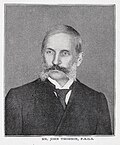File:ANCIENT BUDDHIST ARCH AT KEW-YUNG-KWAN, NANKOW PASS.jpg

Original file (2,712 × 2,160 pixels, file size: 2.15 MB, MIME type: image/jpeg)
| This is a file from the Wikimedia Commons. Information from its description page there is shown below. Commons is a freely licensed media file repository. You can help. |
Summary
| DescriptionANCIENT BUDDHIST ARCH AT KEW-YUNG-KWAN, NANKOW PASS.jpg |
English: John Thomson: A DOUBLE line of wall rises from the village of Kew-yung-kwan, and, running up the mountain side, unites with another wall that sweeps across the crest of the hill. This point is considered one of the most important in the Nankow Pass, and it is the spot where, it is said, Genghis Khan was successfully routed in his attempt to enter the north of China. There is at this village a very remarkable marble arch (see No. 56), erected apparently during the Yuen dynasty, and said to have oricrinally carried a pagoda on its top. This pagoda was taken down shortly after the Ming Emperors got possession of the throne, and this was done to propitiate the Mongols, who were deterred by superstitious fears from passing beneath the shrine. The arch is remarkable on account of its octagonal form, and also for the strange figures from the Indian mythologies with which its surface is adorned. These ornaments very closely resemble many of the sculptures found on the ruined temples of Cambodia. I was at once struck with the similarity when I first saw the arch, and having since compared its entablatures with the photographs which I took in Cambodia in 1866, I find my original impressions confirmed.
It will be observed that the key-stone carries a mythological figure flanked with two others wearing crowns of a seven-headed snake, while the bodies of the snake flow into the ornamentation on either side. The date of the erection of this arch would be about 1345 a.d., at any rate, that is the date of an old inscription on its inner surface. Mr. Williamson mentions a fine arch and marble bridge near Kal-gan, ornamented with marble figures of monkeys, elephants, &c. These structures may prove to belong to the same period, and may point to some connection with Cambodia beyond what we can trace in the style of their ornaments. 1 have obtained further evidence regarding the knowledge possessed by the Chinese of the ancient Cambodians which throws light on the greatest period of their history, or more probably on the epoch when they had ceased to conquer, and were showing unmistakable marks of decline by raising great stone monuments to perpetuate their memory. But as this subject is somewhat foreign to my present work, 1 cannot introduce it here. The interior of the arch is also elaborately sculptured, and two of the kings of the Devas in Buddhist mythology are to be seen on both its inner sides. As to the upper surfaces, these are covered with a great multitude of small images of Buddha carved in bas-relief. Between the two Deva kings is a Buddhist inscription in Sanscrit, with translations into the characters of five other languages, i.e. Thibetan, Mongol, Ouigour, Neu-chih, and Chinese. For a full notice of this inscription see Wylie's Translation, " Journal of the Royal Asiatic Society," vol. v. Part 1 , pp. 14 seq. |
||||||||||||||||||||
| Date |
before 1898 date QS:P,+1898-00-00T00:00:00Z/7,P1326,+1898-00-00T00:00:00Z/9 |
||||||||||||||||||||
| Source | Beinecke Rare Book & Manuscript Library | ||||||||||||||||||||
| Author |
creator QS:P170,Q736862 |
||||||||||||||||||||
Licensing
| Public domainPublic domainfalsefalse |
|
This work is in the public domain in its country of origin and other countries and areas where the copyright term is the author's life plus 70 years or fewer.
| |
| This file has been identified as being free of known restrictions under copyright law, including all related and neighboring rights. | |
https://creativecommons.org/publicdomain/mark/1.0/PDMCreative Commons Public Domain Mark 1.0falsefalse
Captions
Items portrayed in this file
depicts
image/jpeg
ae342ba465ac374299b3f40127283d6cf43c9c8b
2,252,230 byte
2,160 pixel
2,712 pixel
File history
Click on a date/time to view the file as it appeared at that time.
| Date/Time | Thumbnail | Dimensions | User | Comment | |
|---|---|---|---|---|---|
| current | 08:43, 25 January 2014 |  | 2,712 × 2,160 (2.15 MB) | 維基小霸王 | User created page with UploadWizard |
File usage
The following 2 pages use this file:
Metadata
This file contains additional information, probably added from the digital camera or scanner used to create or digitize it.
If the file has been modified from its original state, some details may not fully reflect the modified file.
| Width | 4,239 px |
|---|---|
| Height | 5,687 px |
| Bits per component |
|
| Pixel composition | RGB |
| Orientation | Normal |
| Number of components | 3 |
| Horizontal resolution | 72 dpi |
| Vertical resolution | 72 dpi |
| Software used | Adobe Photoshop CS6 (Windows) |
| File change date and time | 15:48, 23 January 2014 |
| Exif version | 2.21 |
| Color space | Uncalibrated |
| Unique ID of original document | 70E90C04D66B9AC805123277383573A9 |
| Date and time of digitizing | 18:49, 18 January 2014 |
| Date metadata was last modified | 23:48, 23 January 2014 |
| IIM version | 5,823 |
